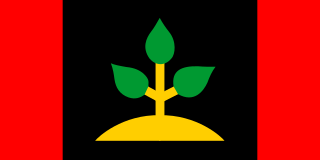
The Larrakia people are a group of Aboriginal Australian people in and around Darwin in the Northern Territory. The Larrakia, who refer to themselves as "Saltwater People", had a vibrant traditional society based on a close relationship with the sea and trade with neighbouring groups such as the Tiwi, Wadjiginy and Djerimanga. These groups shared ceremonies and songlines, and intermarried.
The Madngella, otherwise known as the Matngala or Hermit Hill tribe, are an indigenous Australian people of the Northern Territory, Australia.
The Marranunggu are an Aboriginal Australian people and language group, of the Northern Territory.
The Jadira are a people and territory in the Pilbara region of Western Australia.
The Kutjal were an indigenous Australian people of Queensland of the Cape York Peninsula.
The Wadjiginy, also referred to historically as the Wogait, are an indigenous Australian people of the Northern Territory, specifically from just north of modern-day Darwin. The Wadjiginy are a saltwater people who describe themselves as wagatj 'beach-dwellers' from the Batjamalh word wagatj 'beach'.
The Wulwulam, also known as the Woolwonga, were an indigenous Australian people of the Northern Territory. They are reputed to have been almost completely exterminated in the 1880s in reprisal for an incident in which some members of the tribe speared 4 miners.
The Kwiambal are an Aboriginal Australian people of New South Wales.
The Kambure, more commonly known now as Gamberre, were an Aboriginal Australian people of the Kimberley region of Western Australia.
The Wilawila are an indigenous Australian tribe of the Kimberley region of Western Australia.
The Wurla, also written Ola, or Waladjangarri, are an Aboriginal Australian people of the Kimberley region of Western Australia
The Baiyungu are an Aboriginal Australian people of the Gascoyne region of Western Australia.
The Widi were an Aboriginal Australian people of the Mid West region of Western Australia.
The Doolboong, also known as Duulngari, were an Aboriginal Australian people of the Northern Territory and northeast Western Australia.
The Malngin are an Aboriginal Australian people of the Kimberley region of Western Australia. The Malngin language was a dialect of Gurindj.
The Winduwinda were an indigenous Australian people of Queensland.
The Beriguruk were an indigenous Australian people, now thought to be extinct, of the Northern Territory.
The Djerait were an indigenous Australian people of the Northern Territory
The Pongaponga were an indigenous Australian people of the Northern Territory. They may have been a band of the Ngolokwangga.
The Ngolokwangga are an Aboriginal Australian people of the Northern Territory.